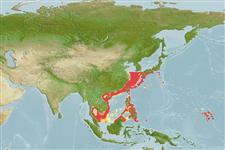Environment: milieu / climate zone / depth range / distribution range
экология
морской демерсальный; пределы глубины 20 - 164 m (Ref. 9494). Tropical; 34°N - 4°N
Western Pacific: South China Sea north to China and Japan (Ref. 9774); also from the Philippines (Ref. 4537).
Size / Вес / Возраст
Maturity: Lm ? range ? - ? cm
Max length : 35.0 cm SL самец/пол неопределен; (Ref. 9774); common length : 22.5 cm SL самец/пол неопределен; (Ref. 9774); наибольший возраст (опубликованны данные): 5 годы (Ref. 72462)
колючие лучи спинного плавника (общее число) : 0; членистые (мягкие) лучи спинного плавника (общее число) : 77 - 89; колючие лучи анального плавника: 0; членистые (мягкие) лучи анального плавника: 60 - 69; позвонки: 37 - 39. Body brownish, a distinct ocellus at junction of straight and curved parts of lateral line. Many dark rings scattered on body, many dark spots on median fins. A line connecting base of dorsal-fin ray and posterior nostril on eyed side passes behind posterior end of maxilla, or crosses its posterior part. Gill rakers moderately long and slender. Soft ray count of pectoral fin refers to that on ocular side (Ref 9774).
Inhabits mud and sand bottoms of shallow coasts or bays (Ref. 9774, 11230, 48637) to 164 m (Ref. 9494). Feeds on small benthic crustaceans and fishes (Ref. 9774). Also caught with small bottom trawls (Ref. 9774). Marketed mostly fresh (Ref. 9774).
Life cycle and mating behavior
половая зрелость | размножение | нерест | икра | Fecundity | личинки
Distinct pairing (Ref. 205).
Masuda, H., K. Amaoka, C. Araga, T. Uyeno and T. Yoshino, 1984. The fishes of the Japanese Archipelago. (plates). Tokai University Press, Shinjuku Tokai Building. Tokyo, Japan. 437 p. (Ref. 711)
Статус Красного Списка МСОП (Ref. 130435: Version 2024-1)
Угроза для людей
Harmless
Использование человеком
рыболовство: коммерческий
дополнительная информация
инструменты
Специальные отчеты
Скачать в формате XML
ресурсы в Интернет
Estimates based on models
Preferred temperature (Ref.
123201): 17.8 - 27.4, mean 23.9 °C (based on 197 cells).
Phylogenetic diversity index (Ref.
82804): PD
50 = 0.5000 [Uniqueness, from 0.5 = low to 2.0 = high].
Bayesian length-weight: a=0.00646 (0.00334 - 0.01248), b=3.14 (2.98 - 3.30), in cm total length, based on LWR estimates for this species & Genus-body shape (Ref.
93245).
Trophic level (Ref.
69278): 4.0 ±0.66 se; based on food items.
Generation time: 3.5 ( na - na) years. Estimated as median ln(3)/K based on 1
growth studies.
устойчивость к внешним воздействиям (Ref.
120179): высокий, минимальное время удвоения популяции до 15 месяцев (K=0.31).
Fishing Vulnerability (Ref.
59153): Low to moderate vulnerability (35 of 100).
